Kabocha squash, or Japanese pumpkin, is a nutrient-dense ingredient perfect for comforting soups. This Thai Kabocha Squash Soup is velvety, comforting flavor profile, and easy to prepare, featuring Thai curry paste and creamy coconut milk for a vegan, gluten-free twist on traditional squash soup.
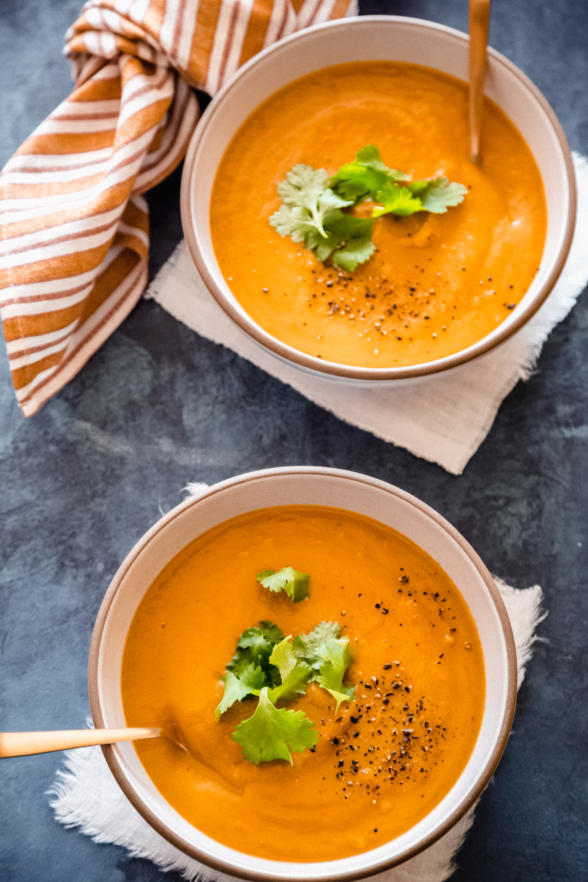
Why You’ll Love This Kabocha Squash Soup
I love introducing my students to healthy, whole ingredients they’ve seen at the market but feel unsure about using—kabocha squash is a perfect example. Over the years, I’ve experimented with kabocha in different ways and created this Thai-inspired soup as a flavorful twist on my classic butternut squash soup recipe.
Kabocha squash is a nutrient-dense ingredient packed with vitamins, fiber, and antioxidants, making this soup both healthy and satisfying. Roasting the squash enhances its naturally nutty and savory flavor, which pairs beautifully with the creaminess of coconut milk and the bold spice of Thai curry paste. The comforting dish is highly customizable—add a touch of maple syrup for sweetness or more curry paste for extra heat to suit your taste.
This easy Thai Kabocha Squash Soup pairs beautifully with a side of crusty bread, a crunchy Thai salad, or a protein-rich main like grilled salmon or crispy baked tofu for a balanced meal. Plus, this creamy soup freezes exceptionally well, making it a great option for making a big batch and enjoying leftovers later.
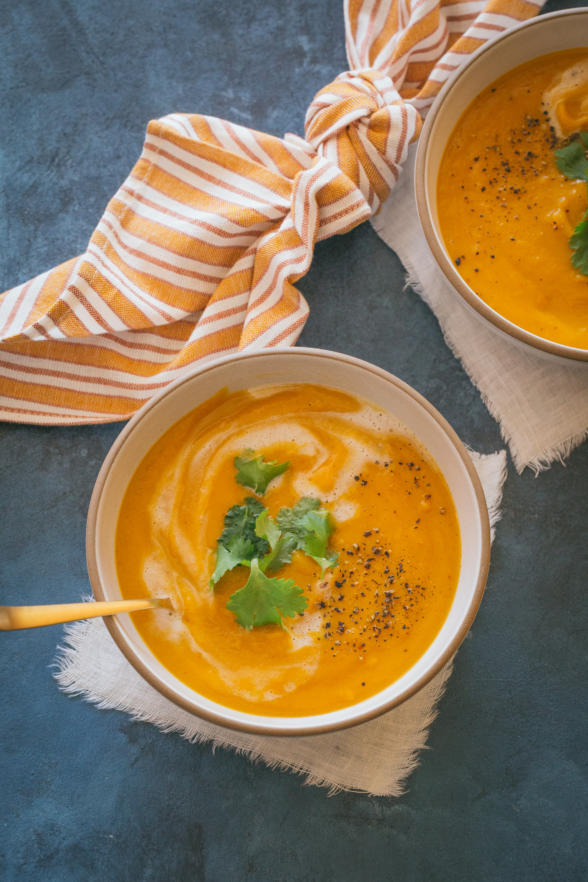
Ingredients You’ll Need
- Kabocha Squash: The star ingredient, roasted to intensify its natural flavor. Look for it in the produce section of stores like Whole Foods, Trader Joe’s, farmers markers, or your local Asian market, especially during the fall and winter season.
- Onion: Adds depth and a savory base to the soup’s flavor. Use yellow onion for its mild, sweet taste when cooked.
- Fresh Ginger: Add depth and warmth to the soup.
- Maple Syrup (Optional): A touch of sweetness to balance the savory flavors.
- Vegetable (if vegan) or Chicken Stock : Use homemade stock for the best flavor, or a quality store-bought option.
- Red Curry Paste: Provides the signature Thai flavor with a touch of spice.
- Sea Salt: Enhances all the flavors.
- Full-Fat Coconut Milk: Adds creaminess and richness.
- Limes, Cilantro, and Red Chiles: For garnishing and a burst of freshness.
Pro Tip: Wash the kabocha squash thoroughly before roasting, as the skin can sometimes have residual dirt or wax.
For exact ingredient amounts, please see the full printable recipe card below.
Step-by-Step Instructions
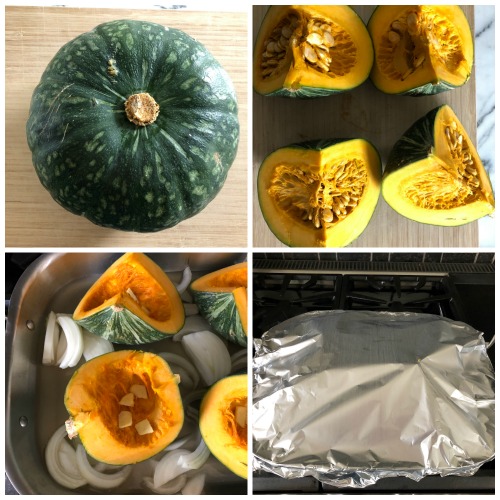
Step 1: Roast the Squash: Preheat your oven to 350°F. Place the squash quarters cut side up in a roasting pan. Divide the ginger slices and maple syrup (if using) among the squash cavities, and arrange onion slices around the squash. Pour 2 cups of stock into the pan, cover tightly with foil, and roast for 90 minutes until the squash is very tender.
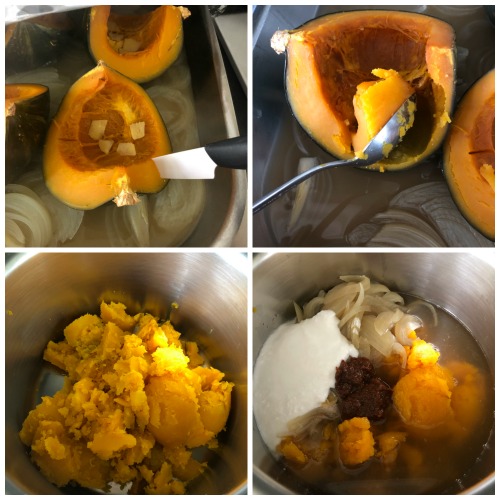
Step 2: Prepare the Soup Base: Allow the roasted kabocha and vegetables to cool slightly. Scoop the pulp from the squash skins and transfer it to a large soup pot. Add the roasted onions, cooking liquid, and ginger (if desired, for a stronger flavor).
Step 3: Combine and Simmer: Add the remaining stock, red curry paste, sea salt, and coconut milk to the pot. Stir to combine, then bring to a boil. Reduce to medium-low heat and simmer uncovered for 10 minutes.
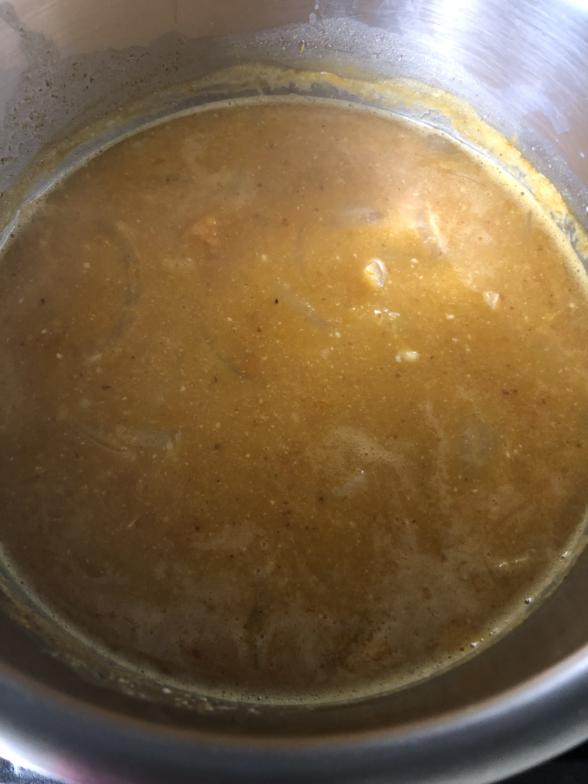
Step 4: Blend Until Smooth: Using an immersion blender, puree the soup directly in the pot until smooth. Alternatively, blend the soup in batches in a blender. Taste and adjust seasoning with additional salt or maple syrup as needed.
Step 5: Garnish and Serve: Ladle the soup into bowls. My favorite way to finish this bowl of soup is with a drizzle of coconut milk, a squeeze of lime juice, fresh cilantro, and sliced red chiles for a pop of flavor and color.
Expert Tips
- Roasting Deepens Flavor: Don’t skip roasting the squash—it caramelizes the natural sugars and adds depth to the soup.
- Control the Heat: Use Thai red curry paste sparingly if you prefer a milder soup, or add more for extra spice.
- Texture Matters: Blend the soup thoroughly for a velvety texture. If using a blender, work in small batches to avoid spills.
- Experiment with Garnishes: Try toasted pumpkin seeds, crispy shallots, green onions, or sautéed quinoa for added crunch.
- Sharp Knife: Make sure your knife is plenty sharp for cutting through Kabocha’s tough skin.
Serving Ideas
This Thai Kabocha Squash Soup is versatile and pairs well with a variety of dishes. Here are some serving suggestions:
- Appetizer: Serve small portions before a main course like Thai chicken skewers or vegetable and soba noodle stir-fry.
- Main Course: Pair with crusty bread and a Thai steak salad for a complete meal.
- Garnish Options: Customize with toppings like toasted coconut flakes, pumpkin seeds, fried shallots, or fresh herbs.
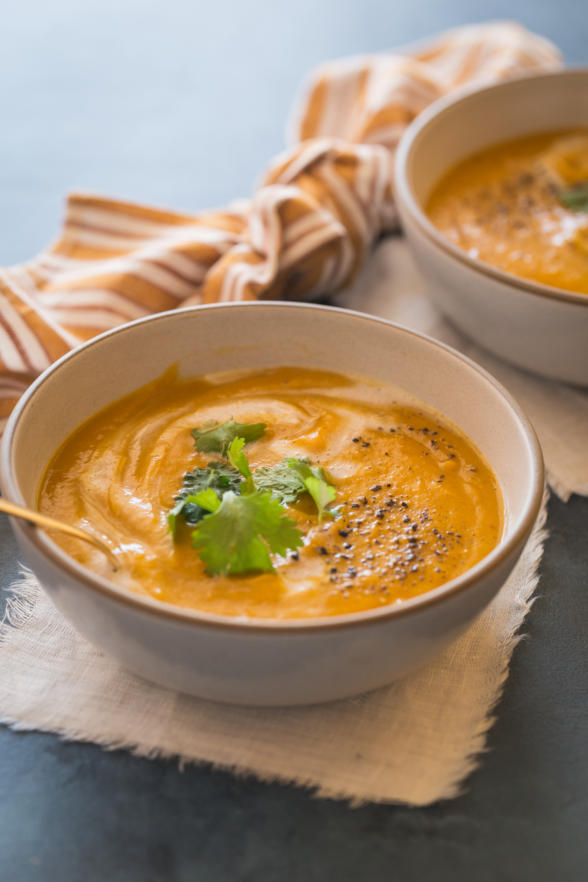
Storage Tips
- Refrigeration: Store leftover soup in an airtight container in the refrigerator for up to 4 days.
- Freezing: Freeze in individual portions for easy reheating. It will keep well in the freezer for up to 3 months.
- Reheating: Reheat gently on the stovetop over medium heat, stirring occasionally. Add a splash of stock or water if the soup thickens after storage.
- Pro Tip: Store garnishes separately to keep them fresh and crisp.
Recipe FAQs
Kabocha squash, also called Japanese pumpkin, is a nutrient-dense winter squash with a dense, nutty flavor. Its texture is less watery and more intense than butternut or acorn squash. It is a beloved ingredient in both Japanese and Thai cuisines, celebrated for its naturally sweet, nutty flavor and its versatility in dishes like soups, curries, and tempura.
Yes! Use vegetable stock instead of chicken stock, and the recipe is naturally vegan thanks to the coconut milk.
To make the soup milder, use less red curry paste or substitute it with a pinch of ground ginger and garlic powder. For more heat, add sliced Thai chiles or a splash of sriracha.
No! This is the best thing about this kabocha soup recipe-no need to peel! After roasting, the squash flesh scoops out easily, leaving the skin behind.
Absolutely! This is a great recipe to serve the next day as it tastes even better as the flavors have melded together. Simply reheat and garnish before serving.
Although I highly recommend roasting the squash, if you’re short on time, you can skip roasting and instead peel and cube the squash, then sauté it with the onions and ginger in a large pot until softened. Add the stock, curry paste, and coconut milk, and simmer until the squash is tender enough to blend. While roasting adds depth of flavor, this method still yields a delicious and quick soup.
More Cozy Soup Recipes
If you give this recipe a try, snap a pic and tag @pamelasalzman so I can see your beautiful creations. I also really appreciate readers taking the time to leave a star rating and review! I have started a weekly Monday newsletter with tips, musings, new recipes not published here, fun new finds, and more. Subscribe for free here.
For more delicious recipes and to learn how to be a better cook, check out my monthly online cooking classes. I have been teaching people for 15 years how to cook healthy food that their families love! Join me!
Flavorful Roasted Thai Kabocha Squash Soup Recipe
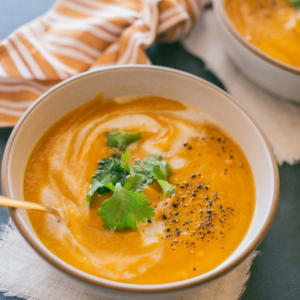
Ingredients
- 1 3-4 pound kabocha squash, washed, quartered and seeds removed
- 1 onion, peeled and thinly sliced
- 1/2 Tablespoon fresh, peeled ginger, thinly sliced
- Optional: 2 Tablespoons pure maple syrup, plus more to taste if you want a bit of sweetness
- 4 cups chicken or vegetable stock, preferably homemade, divided
- 2 Tablespoons red curry paste
- 1 teaspoon sea salt, you will need to double this if your stock is unsalted
- 3/4 cup full-fat coconut milk, plus more for finishing
- 2 limes, cut into thirds
- handful fresh cilantro or mint leaves, sliced
- 2 red chiles, either Thai or Fresno, sliced
Instructions
- Preheat oven to 350 degrees.
- Place the squash pieces cut side up in a roasting pan. Divide the ginger slices and maple syrup evenly amongst the squash cavities. Arrange the onion slices around the squash. Pour 2 cups of stock in the pan and cover tightly with foil. Bake for 90 minutes until squash is very tender.
- Remove the pan from the oven and allow the vegetables to cool slightly or enough that you can handle them. Scoop the squash pulp from the skins and transfer to a large soup pot. Discard skins. To the soup pot add the onions, ginger (if desired, but this will add strong ginger flavor to the soup) and cooking liquid from the pan.
- Add the remaining 2 cups of stock, curry paste, sea salt and coconut milk to the soup pot. Stir well and bring to a boil. Lower heat and simmer, uncovered for 10 minutes.
- Puree the soup until smooth in the pot with an immersion blender or in batches in a blender. Taste for seasoning and add additional salt and/or maple syrup as desired.
- Ladle soup into bowls and drizzle each with a tablespoon of coconut milk, generous squeeze of lime, herbs and sliced red chiles.
Notes
- Roasting Deepens Flavor: Don’t skip roasting the squash—it caramelizes the natural sugars and adds depth to the soup.
- Control the Heat: Use Thai red curry paste sparingly if you prefer a milder soup, or add more for extra spice.
- Texture Matters: Blend the soup thoroughly for a velvety texture. If using a blender, work in small batches to avoid spills.
- Experiment with Garnishes: Try toasted pumpkin seeds, crispy shallots, green onions, or sautéed quinoa for added crunch.
- Sharp Knife: Make sure your knife is plenty sharp for cutting through Kabocha’s tough skin.
- Refrigeration: Store leftover soup in an airtight container in the refrigerator for up to 4 days.
- Freezing: Freeze in individual portions for easy reheating. It will keep well in the freezer for up to 3 months.
- Reheating: Reheat gently on the stovetop over medium heat, stirring occasionally. Add a splash of stock or water if the soup thickens after storage.
- Pro Tip: Store garnishes separately to keep them fresh and crisp.
 Like this recipe? Rate & comment below!
Like this recipe? Rate & comment below!



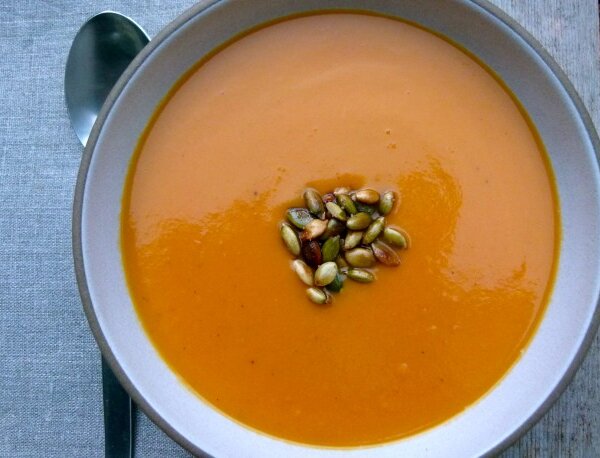

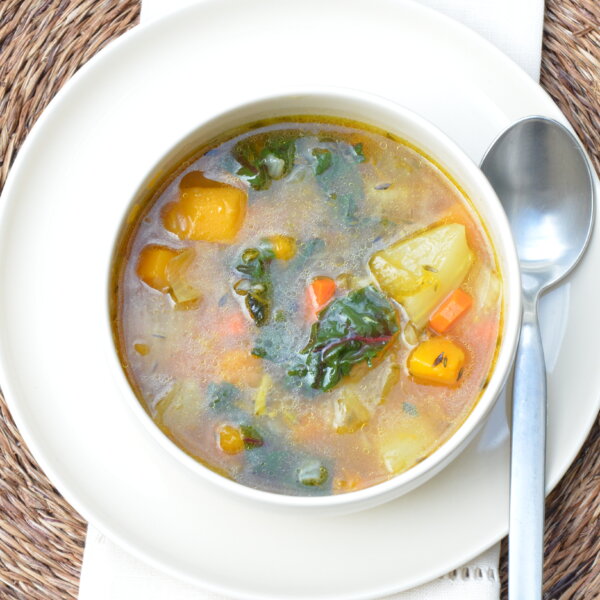
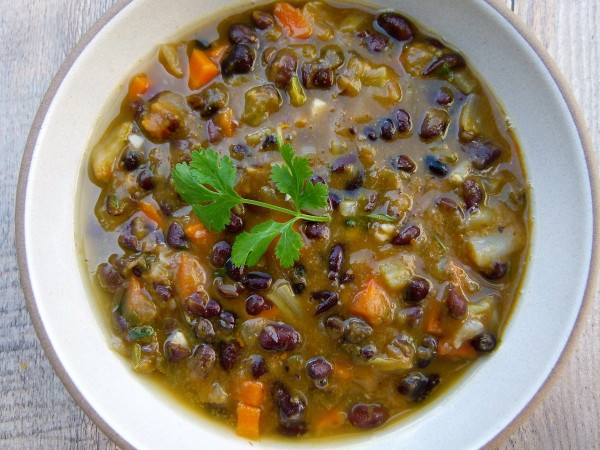
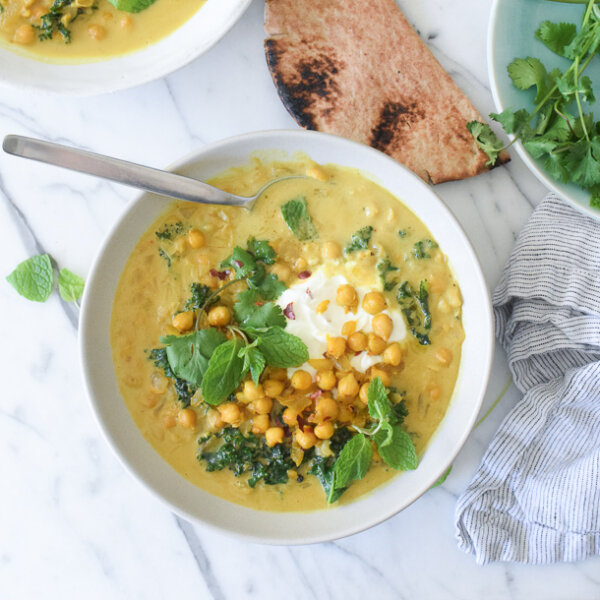
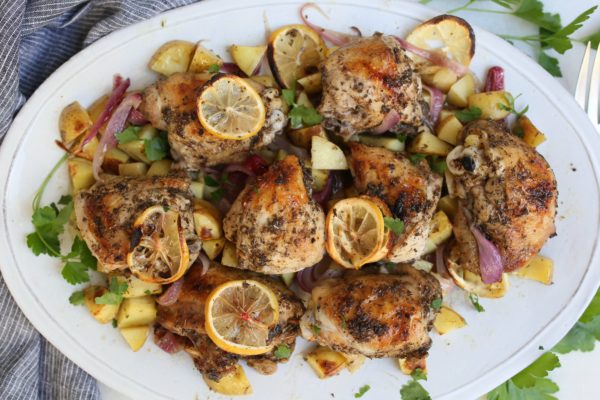
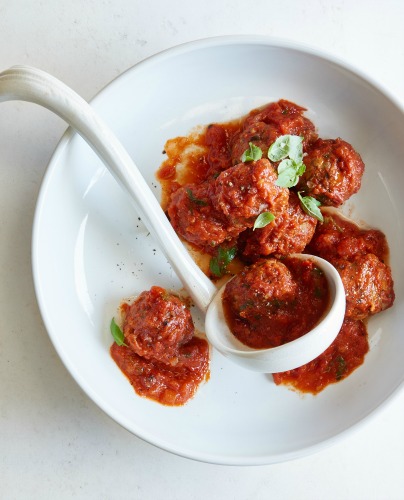






Maesri curry pastes in the little cans are terrific. Can be found in most Asian markets and online.
thanks for the tip!